|
1988 - Hangars and helicopters
The structure of Hangar I had been completed in 1987, but the poor weather toward the end of the year had delayed the construction of the concrete apron and its drainage system. European Helicopters had moved into the new building as they required additional space, not just for the support and maintenance of their customer's helicopters but for their engineering research and development. The new apron was completed during the spring with the drainage being directed into a soak away.
| 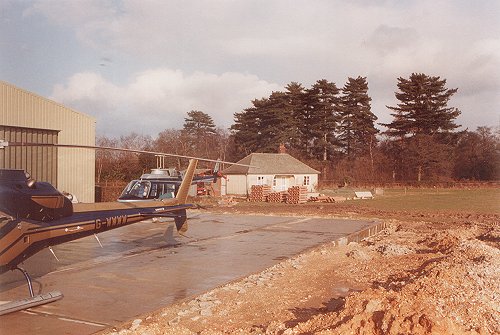
The new Hangar I required an extended apron.
|
|
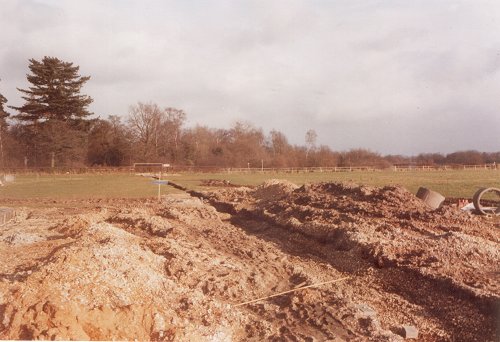
The new apron also required a drain to take rain water away.
|
|
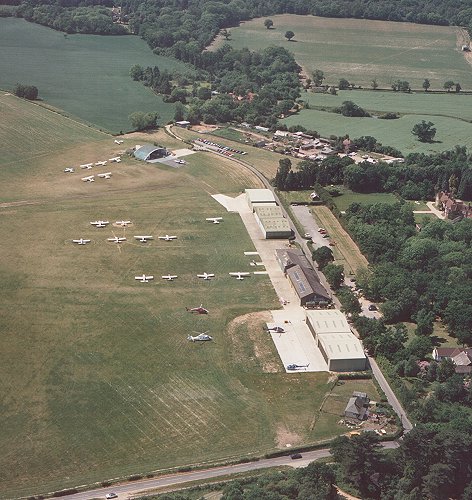
Denham aerodrome in the summer of 1988.
|
|
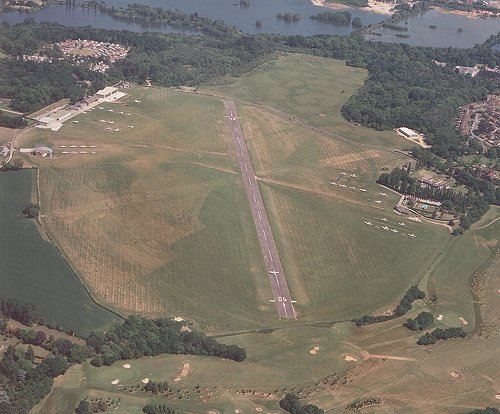
The aerodrome from the west in 1988.
|
Aside from the work on Hangar I, the last remaining Second World War blister hangar on the aerodrome underwent repairs during the year. The Denham Cessna Flight Centre had moved to Denham as they were forced to leave Leavesden when it closed in 1987. The temporary office for the Denham Cessna Flight Centre on the apron of Hangar M had to go, so another temporary building was installed inside the blister hangar. The Denham School of Flying had been promised that there would not be a rival flying school based at Denham, excepting services provided by the aerodrome owner. As a result DCFC was obliged to operate through DSF, who continued to use their Piper aircraft from the south side of the aerodrome while DCFC operated their Cessnas from the blister hangar on the north side. Ultimately, DSF required both schools to operate from the south side from the end of the year.
|
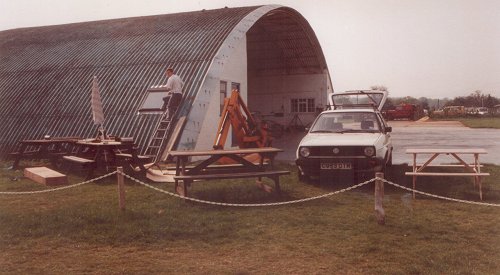
The blister hangar on the North side underwent repairs during 1988.
|
|
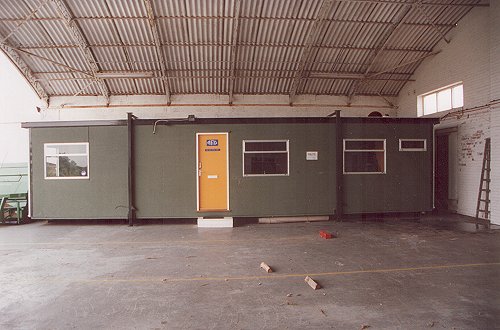
A temporary office building was placed in the blister hangar for the Denham Cessna Flight Centre.
|
|
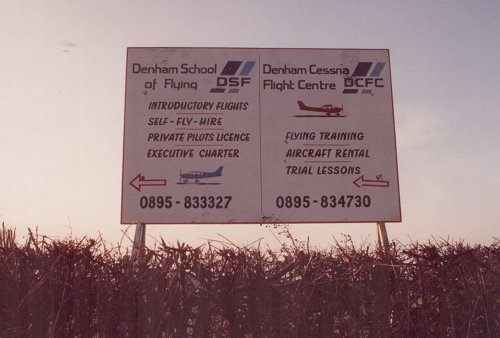
Both of the two flying schools came under the Cabair Group and operated from the south side office buildings by the end of the year.
|
One of the best things about Denham is the people who live there. At the local pub, the Wagon and Horses, a group called the Willing Wheels had been formed with the aim of raising money for terminally ill children. Two of the members, Sue and Jay Ayris, knew of a 16 year old Leukaemia sufferer, Daniel Osbourne and his ambition to be a pilot, the result of his first flight where he had fallen in love with flying. The group set about organising raffles and auctions to raise money and approached the aerodrome to see what could be done to help the young man. In response, the Denham School of Flying arranged for a free flying lesson in July. Daniel took his lesson in a Piper Cherokee along with instructor Meg Crawford and was delighted to take the controls for the first time. As a result, the Willing Wheels group continued their fund raising and purchased a course of flying lessons for Daniel who completed them during the summer.
|
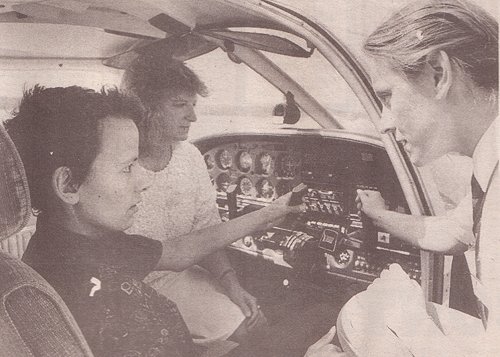
Fundraiser Sue Ayris, Daniel Osbourne and instructor Meg Crawford go over the controls of the Piper Cherokee.
|
1988 saw the arrival of another aircraft which was to become associated with Denham for many years, providing a vitally important service to many people. The story began in 1987, when Consultant Surgeon Richard Earlam of the London Hospital in Whitechapel approached Lord Stevens, the owner of the Express Newspaper Group. His idea was to provide a Helicopter Emergency Medical Service to London and the South East. This would save lives by dramatically shortening the time it took to get critically injured people to hospital from the scene of accidents. Lord Stevens saw the merit of the idea and agreed to fund the service with a two million pound donation, as well as buying a suitable helicopter. The twin engined Aerospatiale AS.365 Dauphin was selected and arrived at Battersea Heliport on 17 December, appropriately registered G-HEMS. European Helicopters, based at Denham, were responsible for maintenance of the powerful aircraft so it became a regular visitor for engineering and upgrades over the next two decades.
|
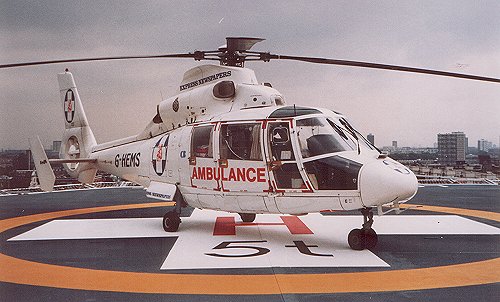
The Aerospatiale AS.365 Dauphin G-HEMS on its helipad on the roof of the London Hospital.
|
In 1938, Squadron Leader J W Gillan in a Hawker Hurricane Mk I had startled the aviation world by making a flight from Edinburgh to Northolt in just 58 minutes, recording an average speed of 408.75 mph, an unheard of velocity for the time. Fifty years after the record breaking flight, Mike Hallam recreated the event to commemorate the achievement. Using his 25 year old Jodel D1051, the flight in the lower powered machine took three and a half hours, but still set a record for aircraft in its class. Because the Jodel was a single engined aircraft, it was unable to land at Notholt, but overflew the airfield before proceeding to Denham.
|
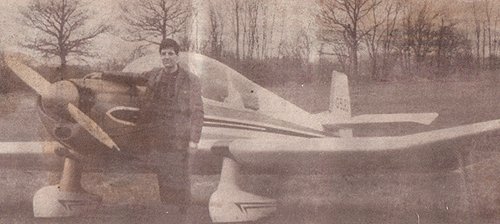
Mike Hallam photographed at Denham with his Jodel for the local paper.
|
|
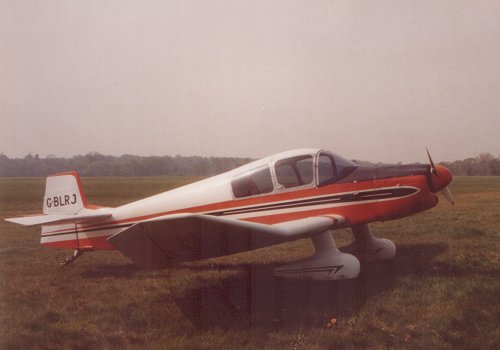
Mike Hallam's Jodel D1051, G-BLRJ, at Denham in 1988.
|
During the course of the year, the Denham School of Flying and the Denham Cessna Flight Centre were both amalgamated under the Cabair Group. This change was reflected in the logos seen on the aircraft of both schools at Denham, and it is interesting to note that two of the aircraft in the images below are still owned and operated by organisations at Denham today, these being G-OWAR and G-BOLI.
|
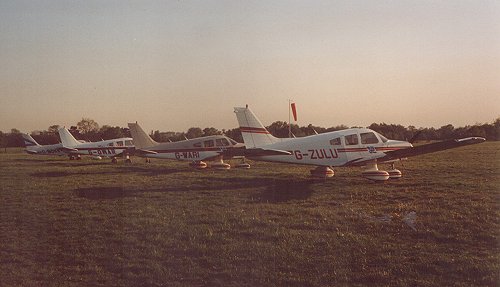
Aircraft of the Denham School of Flying in 1988.
|
|

Aircraft of the Denham Cessna Flight Centre in 1988.
|
|
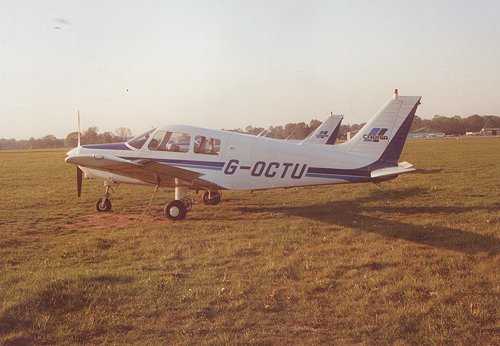
Aircraft wearing the new Cabair Group logo first seen at Denham in 1988.
|
As already mentioned, European Helicopters were expanding their roles in helicopter engineering, research, development and certification. One of the certifications they were working on in 1988 was an ice accretion warning system for helicopter air intakes, specifically those of the Aerospatiale AS.355 Twin Squirrel. The system consited of sensors mounted in the air intakes which fed data to a signal processor, which then triggered a warning light system in the cockpit. This had been developed because advances in helicopter avionics meant that helicopters were now operating at night and in all weathers under instrument flight rules, so ice protection had become increasingly important to these operations. Trials were conducted during 1988 with full certification being granted the following year. European Helicopters also fitted the Bendix EFIS 40 Electronic Flight Instrumentation System to an Italian owned Aerospatiale AS.365 Dauphin 2 in 1988, creating the first helicopter in Europe to be so equipped and certificated. The success of these new ventures meant that space, even in the new hangar, quickly became at something of a premium. Consequently, a planning application was made to extend the new structure forwards by 25 feet. The local council felt unable to make decision and required that it be submitted for public enquiry. Much to the fury of a local resident the appeal was granted on 21 December 1988.
|
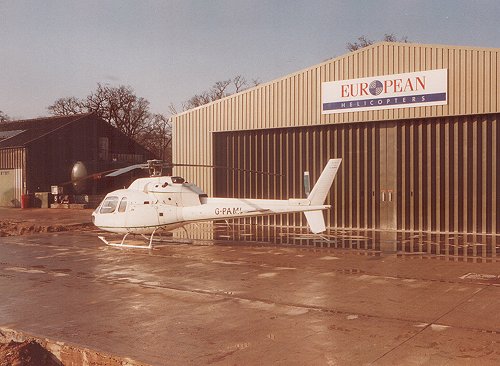
A European Helicopters customer's AS.355 Twin Squirrel outside the new Hangar I at Denham.
|
|
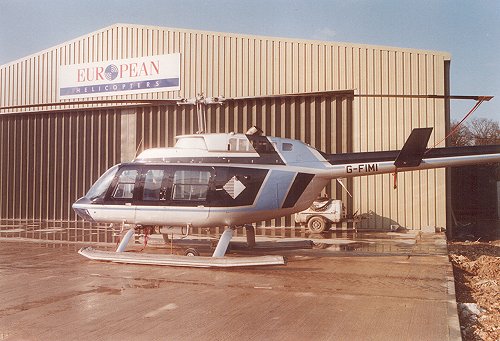
European Helicopters could service a wide variety of aircraft types, such as this Bell 206L LongRanger belonging to Denham based Lynton Aviation.
|
| 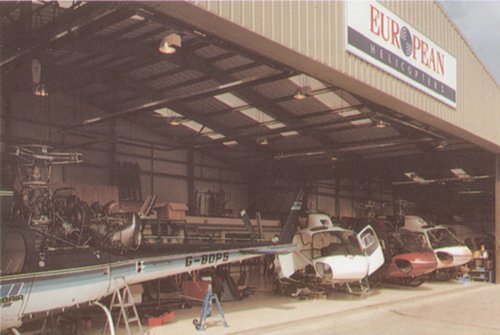
The success of European Helicopters meant that space quickly became at a premium even inside the new hangar.
|
|
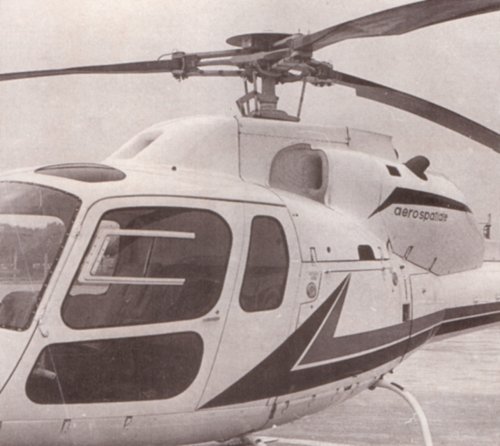
The new ice accretion warning system fitted to the air intake of an AS.355 Twin Squirrel helicopter. Trials were conducted throught the year and certification granted in 1989.
|
As has already been mentioned, Denham was home to two remarkable aerobatic and display pilots, Brian Lecomber and Phillip Meeson who were to achieve very different goals in 1988. Brian Lecomber had been flying aerobatics both in competition and in air displays for ten years and had recently acquired an Extra 230 to compliment his Stampe SV4B biplane. At the time, the record for the number of continuous loops stood at 155 completed in one hour, and Brian was certain that the Extra was capable of breaking this. At the Plymouth Air Show, Brian set a new record of 180 loops in one hour. He explained that "I was asked to do it so the air show could get some advanced publicity and I must have been caught at a weak moment. I didn't practice for it but decided that if I wasn't up to it by now I might as well forget it!" Brian later took Daily Mail journalist Suzanne O'Shea flying in the Stampe to demonstrate the loop after the record breaking flight and told her "It got very dull going round and round for an hour!"
|
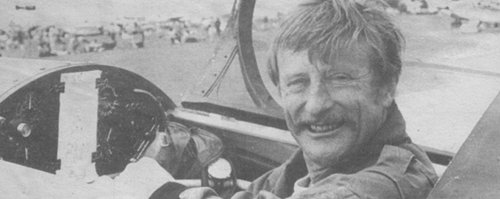
Brian Lecomber in the cockpit of his Extra 230 after having set a new world record for 180 consecutive loops.
|
Phillip Meeson had been a long time resident at Denham flying a variety of Pitts Special biplanes but in 1978 he had started his own airline. Channel Express (Air Services) Ltd was based at Bournemouth and offered air services to the Channel Islands and night cargo operations into European destinations. Equipped with turboprop powered Handley Page Dart Heralds, the fleet was later to include Fokker F27 Freindships and Lockheed L-188 Electras and used the name Express Air Services. It conducted short notice and ad-hoc charters to Europe and North Africa as well as providing wet lease operations on behalf of the major airlines. In 1983 it was rebranded Channel Express and had found a lucrative niche in flying and distributing about 95% of the fresh flower crops of the Channel Islands. To achieve this, it used its aircraft and a fleet of refrigerated lorries, a business worth about £1.2 million a year. By 1988, a number of Royal Mail contracts had added to the firm's fortunes, so Meeson had decided to float the company on the stock exchange, looking to raise about £760,000 with the release of the £0.70p shares, about 25% of the company's equity. The launch was successful, and company going from strength to strength until 2002 when it launched its low cost and holiday airline, Jet2, the name by which it is known today.
|
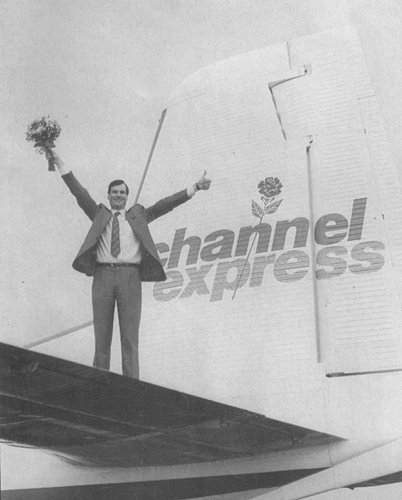
Phillip Meeson with one of his Handley Page Dart Heralds of Channel Express.
|
There were a number of visitors to the aerodrome during the course of the year, the more unusual are recorded below, including one which is not what it appears to be!
|
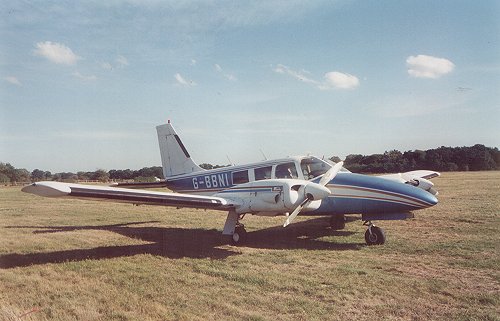
Derek Boyer regularly flew in from Guernsey in his Piper PA34 Seneca to assist his brother, the local gravel merchant W.G Boyer, a man from whom Myles Bickerton had purchased part of the aerodrome.
|
|

An unusual overseas visitor was this French registered Beechcraft A55 Baron.
|
|
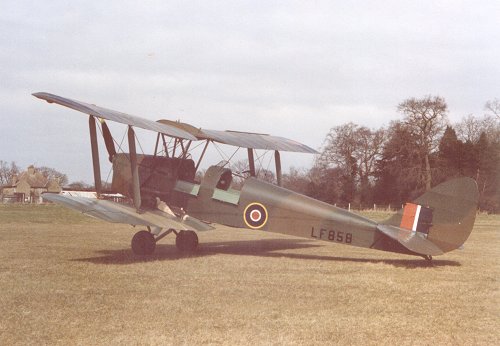
Barrie Bayes owned what appears to be a Tiger Moth but is not. It is in fact a de Havilland dH.82B Queen Bee, a very rare remote control aerial target version of the beloved trainer. This aircraft, registered G-BLUZ, is still flying today in the hands of the appropriately named Bee Keepers Group.
|
A highly unusual event took place at the aerodrome when a hot air balloon was used to help celebrate the marriage of local couple Mr and Mrs P W Long. The balloon made a striking backdrop to the wedding photographs as can be seen here.
|
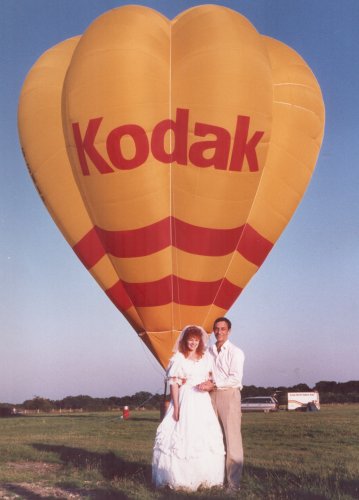
Mr and Mrs P W Long and the hot air balloon they hired for their wedding.
|
All in all a very interesting year for Denham, with a great deal of unusual activity and innovation taking place at the aerodrome. With the planning permission granted for the extension to the new Hangar I, the work would take place the following year, as will be related next.
|
|

